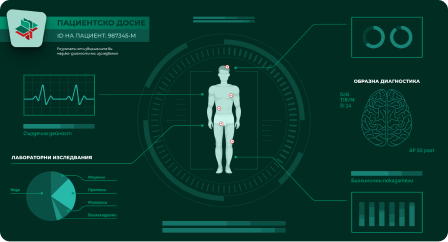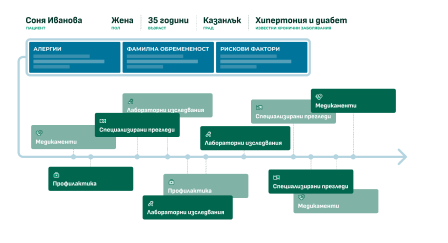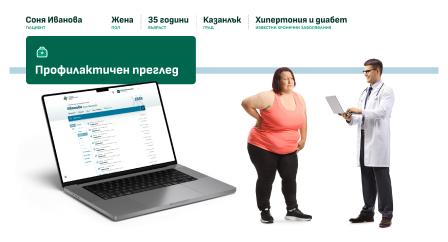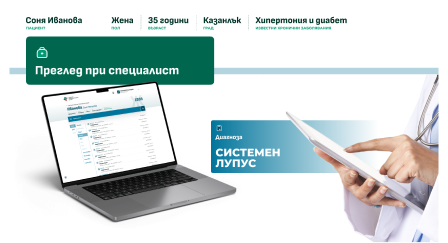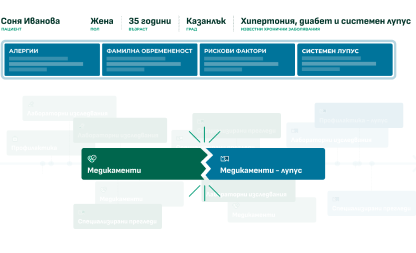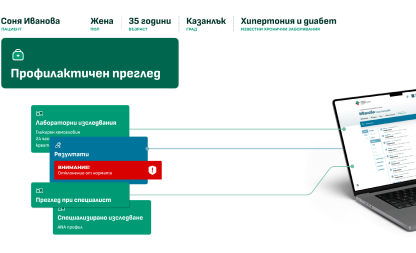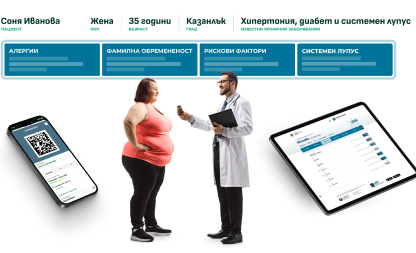Management of the Personal Plan

-
1 Birth or initial registration in the system
-
2 System creates a personal plan and fills it with upcoming events for next 3 months
The initially populated events are from the Preventive Care Calendar – mandatory examinations, immunizations, and tests. For newborns, these include all mandatory examinations according to the Child Health plan, as well as mandatory and recommended vaccinations. For individuals over 18 years old, these events include annual preventive examination and potentially DT (diphtheria-tetanus) re-vaccination. -
3 System marks an upcoming event, creates a diagnostic card for it, and sends a notification to eZdrave
Electronic diagnostic card is created based on predefined rules according to health standards, individual characteristics, risk factors, family history, recent test results, medications taken, administered vaccines, etc. Events whose deadlines have expired are locked. System adds the event to list of upcoming events in GP’s patient list. -
4 Doctor's office visit for the relevant event (examination, immunization, etc.).
Doctor downloads the electronic diagnostic card from NHIS, which contains a list of mandatory and optional indicators, tests, and questions. Doctor performs respective activity. -
5 Doctor performs respective activity (examination, immunization, diagnostic activities).
Doctor registers necessary documents in NHIS and fills in a required diagnostic card containing questions, measurements, tests, prescribed treatment, and scheduled additional examinations (if any). System sends a notification for completed actions. -
6 System marks an event as completed and links it via the National Reference Number (NRN) to the registered electronic document.
-
7 System removes an event from upcoming schedule and updates the personal plan with next event on the list.
-
If an event is missed and its deadline expires, it is marked as incomplete in citizen's medical history. System removes said event from upcoming schedule.
-
1 Birth or initial registration in the system
-
2 System creates a personal plan and fills it with upcoming events for next 3 months
The initially populated events are from the Preventive Care Calendar – mandatory examinations, immunizations, and tests. For newborns, these include all mandatory examinations according to the Child Health plan, as well as mandatory and recommended vaccinations. For individuals over 18 years old, these events include annual preventive examination and potentially DT (diphtheria-tetanus) re-vaccination. -
3 System marks an upcoming event, creates a diagnostic card for it, and sends a notification to eZdrave
Electronic diagnostic card is created based on predefined rules according to health standards, individual characteristics, risk factors, family history, recent test results, medications taken, administered vaccines, etc. Events whose deadlines have expired are locked. System adds the event to list of upcoming events in GP’s patient list. -
4 Doctor's office visit for the relevant event (examination, immunization, etc.).
Doctor downloads the electronic diagnostic card from NHIS, which contains a list of mandatory and optional indicators, tests, and questions. Doctor performs respective activity. -
5 Doctor performs respective activity (examination, immunization, diagnostic activities).
Doctor registers necessary documents in NHIS and fills in a required diagnostic card containing questions, measurements, tests, prescribed treatment, and scheduled additional examinations (if any). System sends a notification for completed actions. -
6 System marks an event as completed and links it via the National Reference Number (NRN) to the registered electronic document.
-
7 System removes an event from upcoming schedule and updates the personal plan with next event on the list.
-
If an event is missed and its deadline expires, it is marked as incomplete in citizen's medical history. System removes said event from upcoming schedule.
